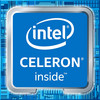Intel Core i3-3217U vs Intel Celeron J4105
Intel Core i3-3217U
► remove from comparisonThe Intel Core i3-3217U is an ULV-processor for laptops based on the Ivy Bridge architecture released in Q2 2012. Due to Hyperthreading, the two cores can handle up to four threads in parallel leading to better utilization of the CPU. Each core offers a base speed of 1.8 GHz, Turbo Boost is not supported. As its Sandy-Bridge-based predecessors, it offers a 3 MB L3-Cache.
Ivy Bridge is an enhanced die shrink of the Sandy Bridge architecture with improvements on both GPU and CPU performance. The CPUs are produced in 22nm (versus 32nm Sandy Bridge CPUs) and are the first to introduce 3D transistors for increased energy efficiency when compared to similarly clocked Sandy Bridge processors. Other new features are integrated PCI Express 3.0 and DDR3(L)-1600 support.
The performance of the Core i3-3217U is slightly above a similarly clocked Sandy Bridge processor due to slight architectural improvements. Therefore, overall performance is just a bit below the former Core i5-2467M.
The integrated Intel HD Graphics 4000 offers 16 Execution Units (EUs) clocked at 350 MHz up to 1050 MHz with Turbo Boost, delivering a performance comparable with an AMD Radeon HD 6620G.
The ULV-CPUs are rated at a TDP of 17 W including graphics card and memory controller. Therefore, the CPU is suited for small laptops and ultrabooks.
Intel Celeron J4105
► remove from comparison
The Intel Celeron J4105 is a quad-core desktop SoC primarily for mini PCs and mini ITX mainboards. It runs at 1.5 - 2.5 GHz (Single Core Burst) and is based on the Gemini Lake platform. Similar to the Apollo Lake predecessor, the chip is manufactured in a 14 nm process with FinFETs but offers slightly improved processor cores, double the amount of L2 cache, a smaller package, a new generation of monitor outputs (Gen 10) and a partly integrated WiFi chip. Besides four CPU cores, the chip also includes a DirectX 12 capable GPU as well as a DDR4/LPDDR4 memory controller (dual-channel, up to 2400 MHz). The SoC is not replaceable as it is directly soldered to the mainboard.
Architecture
The processor architecture was slightly reworked and is now called Goldmont Plus. It features an increased level 2 cache (to 4 MB). That means the per-clock-performance should be a bit better, but not near the Core CPUs like Kaby Lake Y.
Performance
While we have not tested a single system built around the J4105 as of August 2023, we have tested a certain number of laptops featuring the Celeron N4120, a chip with very similar specs (4 cores, 4 threads, up to 2.6 GHz). Based on that, expect the J4105 to be very slow in all but the most basic activities.
| Model | Intel Core i3-3217U | Intel Celeron J4105 | ||||||||||||||||||||||||||||||||||||||||||||||||
| Codename | Ivy Bridge | Gemini Lake | ||||||||||||||||||||||||||||||||||||||||||||||||
| Series | Intel Core i3 | Intel Gemini Lake | ||||||||||||||||||||||||||||||||||||||||||||||||
| Series: Gemini Lake Gemini Lake |
|
| ||||||||||||||||||||||||||||||||||||||||||||||||
| Clock | 1800 MHz | 1500 - 2500 MHz | ||||||||||||||||||||||||||||||||||||||||||||||||
| L1 Cache | 128 KB | |||||||||||||||||||||||||||||||||||||||||||||||||
| L2 Cache | 512 KB | 4 MB | ||||||||||||||||||||||||||||||||||||||||||||||||
| L3 Cache | 3 MB | |||||||||||||||||||||||||||||||||||||||||||||||||
| Cores / Threads | 2 / 4 | 4 / 4 | ||||||||||||||||||||||||||||||||||||||||||||||||
| TDP | 17 Watt | 10 Watt | ||||||||||||||||||||||||||||||||||||||||||||||||
| Technology | 22 nm | 14 nm | ||||||||||||||||||||||||||||||||||||||||||||||||
| Die Size | 118 mm2 | |||||||||||||||||||||||||||||||||||||||||||||||||
| max. Temp. | 105 °C | 105 °C | ||||||||||||||||||||||||||||||||||||||||||||||||
| Socket | FCBGA1023 | BGA1090 | ||||||||||||||||||||||||||||||||||||||||||||||||
| Features | Hyper-Threading, Virtualization VT-x, Intel 64, Anti-Theft, My WiFi, Idle States, Enhanced SpeedStep, Thermal Monitorin, Execute Disable Bit | DDR4-2400/LPDDR4-2400 RAM, PCIe 2, MMX, SSE, SSE2, SSE3, SSSE3, SSE4.1, SSE4.2, VMX, SMEP, SMAP, MPX, EIST, TM1, TM2, Turbo, AES-NI, RDRAND, RDSEED, SHA, SGX | ||||||||||||||||||||||||||||||||||||||||||||||||
| iGPU | Intel HD Graphics 4000 (350 - 1050 MHz) | Intel UHD Graphics 600 (250 - 750 MHz) | ||||||||||||||||||||||||||||||||||||||||||||||||
| Architecture | x86 | x86 | ||||||||||||||||||||||||||||||||||||||||||||||||
| $225 U.S. | $107 U.S. | |||||||||||||||||||||||||||||||||||||||||||||||||
| Announced | ||||||||||||||||||||||||||||||||||||||||||||||||||
| Manufacturer | ark.intel.com | ark.intel.com |
Benchmarks
Average Benchmarks Intel Core i3-3217U → 100% n=2
Average Benchmarks Intel Celeron J4105 → 146% n=2
* Smaller numbers mean a higher performance
1 This benchmark is not used for the average calculation













